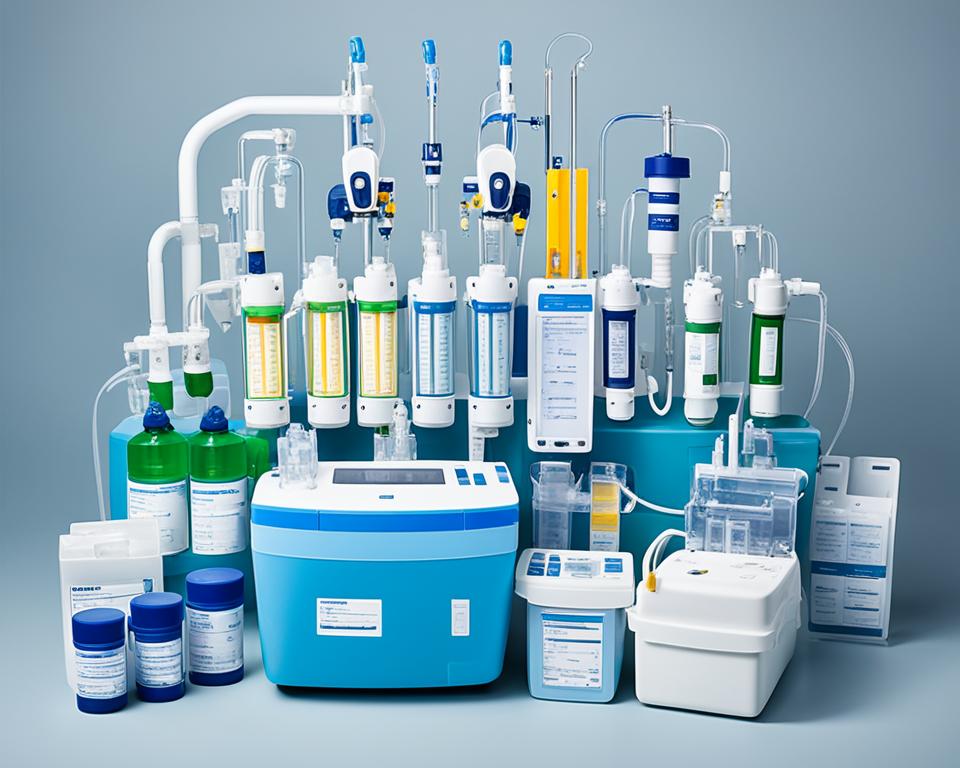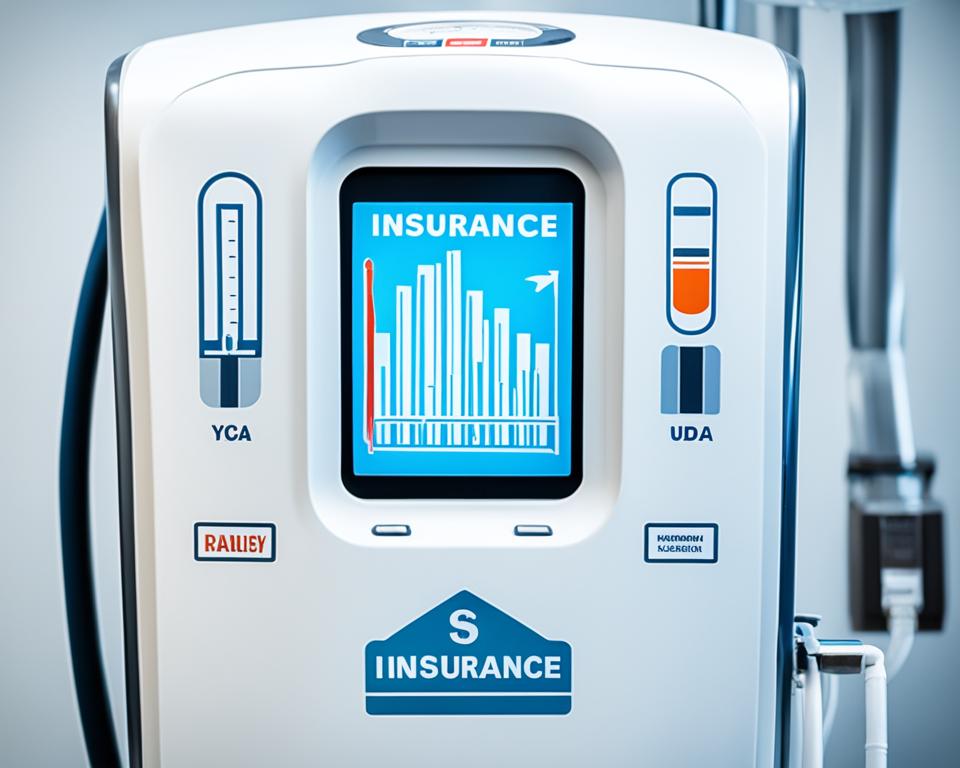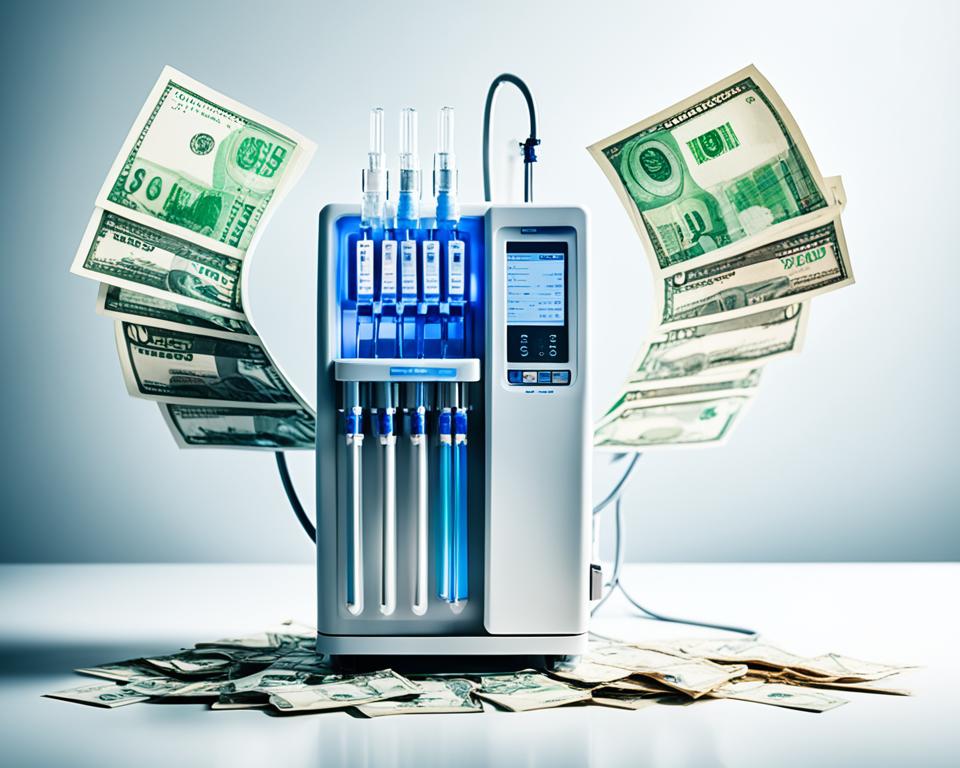Dialysis machines are key in treating those with kidney failure or end-stage renal disease. They filter and purify blood, which is vital for patient health. But, getting and keeping these machines can be tough for clinics, patients, and health providers. This guide explores the many factors that affect the cost of dialysis machines, giving a clear view of the expenses tied to this crucial medical device.
Read interesting things at : vsocan
Key Takeaways
- Dialysis machines are crucial in healthcare for those with kidney failure or end-stage renal disease.
- The cost of these machines changes a lot, affected by the type, brand, new or used, and the supplies needed.
- Repair and maintenance costs, and how the machine cost impacts treatment choices, are big deals for both health providers and patients.
- It’s vital to understand dialysis machine costs to wisely choose treatment and manage health budgets.
- New tech, like portable and wearable machines, could bring new cost factors in the future.
Understanding Dialysis Machines
Dialysis machines help filter and clean blood for people with kidney failure. Each machine type meets different patients’ needs. Knowing about these machines’ types and features helps figure out their cost.
Types of Dialysis Machines
Hemodialysis and peritoneal dialysis machines are the main two types. Hemodialysis filters blood outside the body, while peritoneal uses the stomach lining as a filter.
- Hemodialysis Machines: Found in clinics or hospitals, these are for more serious cases. They clean blood quickly and are larger.
- Peritoneal Dialysis Machines: Smaller and for home use. They let patients do treatments alone or with help.
New dialysis machines aim to be portable and wearable. These let patients move around more while getting treatment.
Functions and Features
Dialysis machines have many features for safety and effectiveness. Important features include:
- They control the rate at which blood flows, which is crucial for good filtration.
- The dialyate fluid flow is also regulated to keep a good balance.
- They can remove extra fluids from the body safely, avoiding dehydration or overhydration.
- Modern machines keep an eye on blood pressure and body temperature in real-time to keep the patient safe.
The features and functions make dialysis machines cost more. Special and advanced equipment has a higher price.
Knowing about the types and features of dialysis machines helps in understanding their costs. This knowledge is key for patients and healthcare providers. It helps in choosing the best dialysis solution for each situation.
Factors Affecting Dialysis Machine Costs
The price of dialysis machines can change a lot. This is because of many reasons. It’s important for healthcare providers, dialysis centers, and patients to know what affects the price. This helps make smart choices when buying.
The type of dialysis machine is a big factor in its cost. Machines with lots of features and new technologies are more expensive. The brand and manufacturer also matter. Well-known companies usually charge more for their machines.
- The features and tech in the machine can make a big difference in the price.
- The condition, whether it’s new or used, also affects the cost. Used machines are usually cheaper than new ones.
- Where you buy the machine from can change the price too. Shipping costs, local taxes, and the market in that area all play a part in the price.
- Buying a lot of machines at once can get you a discount. This is good for healthcare providers and dialysis centers.
Knowing about these factors can help healthcare workers and patients. It lets them make better choices. They can find ways to get and keep their dialysis machines at a good price.
“Knowing the variables that impact dialysis machine pricing can empower healthcare organizations to make strategic investments and ensure the long-term sustainability of their dialysis services.”
Average Cost of Dialysis Machines
The cost of dialysis machines varies a lot. It depends on the type, manufacturer, and what features the machine has. This makes finding the right price tricky. We’ll look at how much new and used machines usually cost. This info is helpful for doctors and patients shopping for dialysis machines.
New vs. Used Machines
Deciding between a brand-new dialysis machine or a used one affects the cost a lot. New machines usually cost between $20,000 and $50,000, and sometimes even over $100,000. They come with new tech, warranties, and help from the maker.
Used or refurbished dialysis machines can save you a lot of money. Their price is often between $5,000 and $30,000. They’ve been checked, fixed up, and work like new. They are a good choice for those with a smaller budget. But, you should make sure they’re safe and meet quality standards.
| Dialysis Machine Type | Average Cost |
|---|---|
| New Dialysis Machine | $20,000 – $50,000 |
| Used/Refurbished Dialysis Machine | $5,000 – $30,000 |
Choosing between new and used depends on what you need and can spend. Do some homework. Knowing the costs and what each choice offers helps you make the best decision. It’s all about fitting your needs and budget.
how much dialysis machine cost
Dialysis machines are key for kidney care. Their prices can change a lot. They’re used by healthcare providers, in dialysis clinics, and by patients.
A basic hemodialysis machine starts at $10,000. More advanced models go up to $50,000. Peritoneal dialysis machines, used at home, are between $15,000 and $30,000.
If you need something easier to move, portable options are available. These cost from $20,000 to $40,000. The price depends on their features and the brand.
| Dialysis Machine Type | Typical Cost Range |
|---|---|
| Hemodialysis Machine | $10,000 – $50,000 |
| Peritoneal Dialysis Machine | $15,000 – $30,000 |
| Portable/Wearable Dialysis Machine | $20,000 – $40,000 |
The dialysis machine pricing changes based on the maker and new tech. Picking the best machine means looking at these factors. It’s to get the most value and best results for patients.
Dialysis Machine Pricing by Brand
The cost of a dialysis machine depends a lot on its brand. Major companies like Fresenius Medical Care, Baxter International, B. Braun, and Nipro sell these machines. They come in various prices and have different features.
To choose the right dialysis machine, it’s important to check the costs and features of these leading brands. This way, doctors and patients can pick the best one for their needs.
Top Dialysis Machine Manufacturers
Fresenius Medical Care is a big name in dialysis solutions. Their machines cost between $20,000 and $50,000. The price varies based on the model and features.
Baxter International, another big player, features machines priced around $25,000 to $35,000. Then there’s B. Braun, known for quality tech, selling machines from $18,000 to $28,000.
Nipro, a Japanese brand, sells machines between $15,000 and $25,000. The prices reflect the technology and unique features each brand offers. For example, more expensive machines might have advanced monitoring or better user interfaces.
Choosing the right dialysis machine is a big decision for healthcare providers and patients. They should weigh their needs against the available features and costs. Knowing the prices from top brands helps make smarter decisions within their budgets.
Cost of Dialysis Supplies and Accessories
In addition to the dialysis machine, patients and healthcare providers need to think about the costs of supplies. These include dialysate fluids, tubing, filters, and monitoring devices. Knowing the expenses after buying the machine helps in planning for full dialysis care.
The cost of dialysis supplies changes a lot based on patient needs, dialysis type, and equipment brand. Monthly, these supplies might cost $500 to $2,000 for each patient, or even more.
Some items and their prices are:
- Dialysate fluids: $50 to $300 per treatment
- Dialysis tubing and filters: $50 to $150 per treatment
- Blood pressure monitors: $50 to $500 each
- Scales and more monitoring tools: $100 to $500 each
Costs depend on patient’s needs, dialysis provider, and insurance coverage. Research and budgeting help keep dialysis care costs manageable for all involved.
“The ongoing cost of dialysis supplies and accessories can be a significant financial burden, but with proper planning and resource management, patients and providers can ensure that quality care remains accessible and affordable.”

Understanding dialysis supply costs aids patients and providers in making smart choices. This essential knowledge makes sure people with kidney disease can afford the care they require.
Maintenance and Repair Expenses
Keeping dialysis machines in top shape is key for their long life and peak performance. Their maintenance and repair costs significantly influence the total expense of owning and using these vital medical tools.
Preventive Maintenance
Doing regular checks and calibrations is crucial. It keeps dialysis machines working well and reliable. This involves regular inspections and making sure the machine is as good as new. The price for this upkeep can change based on who made the machine, its model, and how often it gets serviced. Usually, it costs between $500 to $2,000 each year.
Repair and Replacement Costs
Parts of a dialysis machine might break or not work right over time. This leads to the need for repairs or new parts. The cost to fix these machines can be anywhere from a few hundred to several thousand dollars. It all depends on what’s wrong, if parts are available, and the labor needed from a skilled technician.
It’s important to plan for dialysis machine maintenance costs and repair bills. This helps keep dialysis treatment reliable and avoids hiccups in patient care. By doing regular maintenance and fixing problems early, you can lower the risk of hefty repair costs. This makes dialysis services more affordable in the long run.
“Proper maintenance and timely repairs are crucial for ensuring the longevity and optimal performance of dialysis machines.”
Dialysis Clinic vs. Home Dialysis Costs
Deciding between in a dialysis clinic or at home is important, especially for your wallet. Knowing the cost of machines, setup, and upkeep is key. This helps patients and doctors manage the costs of treatment well.
Dialysis Clinic Equipment Costs
At a dialysis clinic, you’ll find top-notch machines and systems meeting strict standards. The price for these dialysis clinic equipment can be $30,000 to $50,000 each. Tack on costs for putting it in, keeping it running, and replacing parts over time.
Home Dialysis System Prices
Home systems are made to be smaller and easy for everyday people to use. They cost less, from $15,000 to $25,000 upfront. But remember, you’ll also spend more on getting your home ready, learning how to use it, and for support and supplies.
| Dialysis Setting | Equipment Costs | Ongoing Expenses |
|---|---|---|
| Dialysis Clinic | $30,000 – $50,000 per machine | Maintenance, replacement, utilities |
| Home Dialysis | $15,000 – $25,000 for initial setup | Home modifications, supplies, training, support services |
Ultimately, choosing where to do dialysis is about what works best for you and your budget. By knowing the differences in cost, patients and doctors can make better choices. They can then pick the option that fits their needs and money situation for the long term.
“The decision between dialysis clinic and home dialysis should be based on a careful evaluation of the patient’s medical condition, lifestyle, and financial situation.”
Insurance Coverage and Reimbursement
The cost of dialysis machines is important. Insurance coverage and reimbursement really matter. Knowing what Medicare, Medicaid, and private plans help with is key. It makes getting and keeping dialysis equipment easier.
Medicare helps older individuals, certain disability cases, and those with ESRD. It covers some dialysis machine costs. Insurance coverage for dialysis machines and dialysis equipment reimbursement is available for those who qualify.
Medicaid helps low-income people with the cost of dialysis machines and supplies. Each state might have different rules. So, checking if you qualify for Medicaid is important to see what they can help with.
Private insurance also might help with costs. They offer insurance coverage for dialysis machines and dialysis equipment reimbursement. But, the support they give can be different from one plan to another. Some might offer more help than others.
Knowing about insurance and how it works is crucial. Staying informed about insurance coverage and policies is a must. This helps patients and healthcare providers deal with dialysis care costs better.

“Navigating the insurance landscape can be a complex challenge, but understanding your coverage options can make a significant difference in the overall cost of dialysis care.”
Cost-Saving Strategies for Dialysis Centers
Dialysis centers and healthcare providers work constantly to cut costs linked to dialysis machines. They do this to sustain their finances better. This, in turn, allows them to offer more affordable yet quality care to their patients.
One way to save money is by joining forces with other centers through group purchasing deals. This can help centers snag better prices on equipment, supplies, and services. Another cost-saving tip is to look into used or refurbished machines. They’re less expensive than new ones but still do a great job.
Another key to saving is by making sure each machine is used effectively. Centers should study how many patients they serve and how often the machines are used. This data helps them make the most of their equipment and avoid letting machines sit unused. Setting up regular checks on the machines can also make them last longer. This means less need to spend money on fixing or buying new machines.
- Leverage group purchasing agreements to negotiate better prices on dialysis equipment and supplies
- Explore used or refurbished dialysis machines as a cost-effective alternative
- Optimize machine utilization by aligning patient volume and usage patterns
- Implement preventive maintenance programs to extend the lifespan of dialysis equipment
By using these strategies, dialysis centers can slash their equipment costs. This helps them be more financially stable. And it’s good news for both the centers and their patients.
“Prudent cost management is essential for dialysis centers to maintain their financial viability and continue providing high-quality care to patients.”
Portable and Wearable Dialysis Machines
The dialysis world is changing fast with new portable and wearable machines. These tech advances give patients more freedom and flexibility in their treatments. It’s important to think about the costs and pros and cons of these options for dialysis care.
Portable Dialysis Unit Prices
Portable dialysis machines let patients move around. They usually cost between $10,000 to $30,000. The price can change depending on the brand and technology the machine uses.
Wearable Dialysis Machine Costs
Wearable dialysis devices, known as “artificial kidneys,” are growing in popularity. They can cost from $20,000 to $50,000. Their tech and small size make them a bit more expensive.
Advantages and Disadvantages
- These machines let users be more mobile, fitting dialysis into their daily lives easily.
- Users can also do their treatments more often and whenever it suits them, which might help their health.
- But, they are quite pricey, which might stop some people or hospitals from getting them.
- They also need regular checks to keep working right, which could increase the overall care cost.
The dialysis field is getting better with more options like these portable and wearable machines. But, it’s key to think about their costs and what they offer. This helps patients and hospitals choose what’s best for both health and budget.
Emerging Technologies and Future Costs
The dialysis equipment market is changing quickly due to new technology and creative solutions. These new technologies will impact the future costs of dialysis machines and how dialysis care is given.
Artificial intelligence (AI) is becoming more widely used in dialysis machines. AI can look at data in real-time to make personalized treatment plans. This can make dialysis more efficient, lowering costs over time.
There’s also a growing need for remote monitoring and telehealth in dialysis care. Devices that patients can wear and systems for remote monitoring watch vital signs and how well patients are taking their medicine. This helps doctors act quickly to problems and may cut down on the times patients need to come in, which could lessen the overall costs of dialysis.
Work is also being done on personalized dialysis systems. These machines will be able to change according to each patient’s body and needs. While they might cost more at first, they could lead to fewer complications and hospital visits, which would save money in the long run.
The field of dialysis is always changing. This constant evolution means future dialysis machine costs and the effect of emerging dialysis technologies will play a big role in the future of dialysis care.
“The dialysis industry is on the cusp of a technological revolution, with the potential to drastically improve patient outcomes and reduce long-term costs.”
Choosing the Right Dialysis Machine
Choosing a dialysis machine is about more than the price. You must look at what it can do, its size, how easy it is to use, and if it matches the needs of the patient or hospital. Make sure it fits the treatment needs and the budget.
Think about what treatments the machine can do, like hemodialysis. Check if it can adjust the flow rates and treat water well. This must meet the patient’s or the facility’s needs.
The machine’s size and how easy it is to move are important too. In a hospital, a small and light machine might be better. But for home use, portability is key.
Ease of Use and Maintenance
Any dialysis machine should be easy to operate. It should have clear controls and displays so anyone, even a patient, can use it. Think about how easy it is to maintain, if parts are easy to get, and if it’s simple to fix when needed.
Compatibility and Regulatory Compliance
Make sure it works with the water and power where it will be used. Check if it follows safety rules and laws. This is crucial for the machine to work well and safely.
Considering these points helps both healthcare workers and patients choose wisely. It helps find the best dialysis machine for their needs and budget.
| Key Factors | Considerations |
|---|---|
| Dialysis Capabilities | Treatment modalities, flow rates, water treatment |
| Size and Portability | Compact design, lightweight, ease of transportation |
| Ease of Use | Intuitive controls, clear displays, user-friendly operation |
| Maintenance | Frequency of servicing, availability of parts, troubleshooting |
| Compatibility | Facility infrastructure, water supply, power requirements |
| Regulatory Compliance | Meeting safety and performance standards |
“Selecting the right dialysis machine is crucial for ensuring effective and efficient treatment. By carefully evaluating key factors, healthcare providers and patients can make an informed decision that meets their specific needs and budgets.”
Conclusion
We have learned that the cost of dialysis machines is complex. It depends on many things like new or used machines. Plus, there are costs for keeping them up and running. This knowledge is important for both patients and their healthcare providers.
Understanding the cost includes looking at the price to buy, the brand, and if it has special features. There are also costs for using it over time. Knowing these things helps people make smart choices.
The price of dialysis machines matters a lot in healthcare decisions and costs. This guide helps readers understand how to deal with equipment costs. It’s about making care good, available, and not too expensive for everyone.


